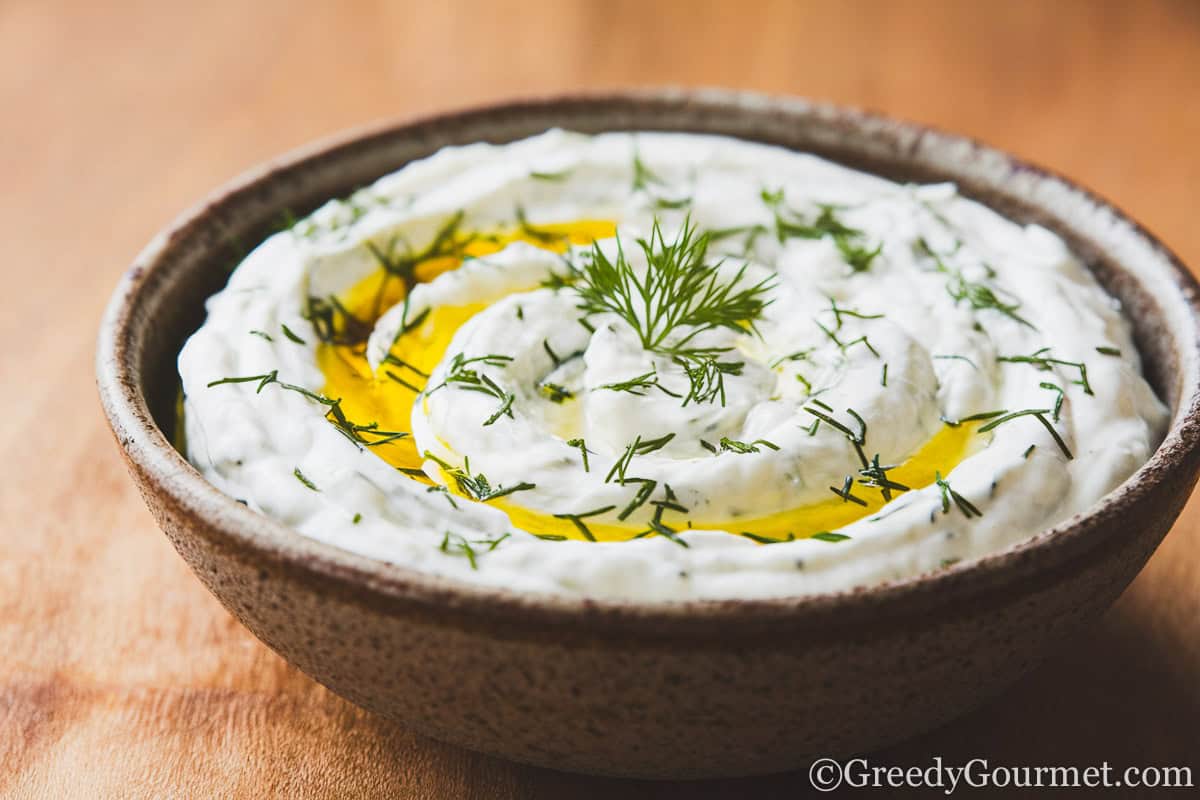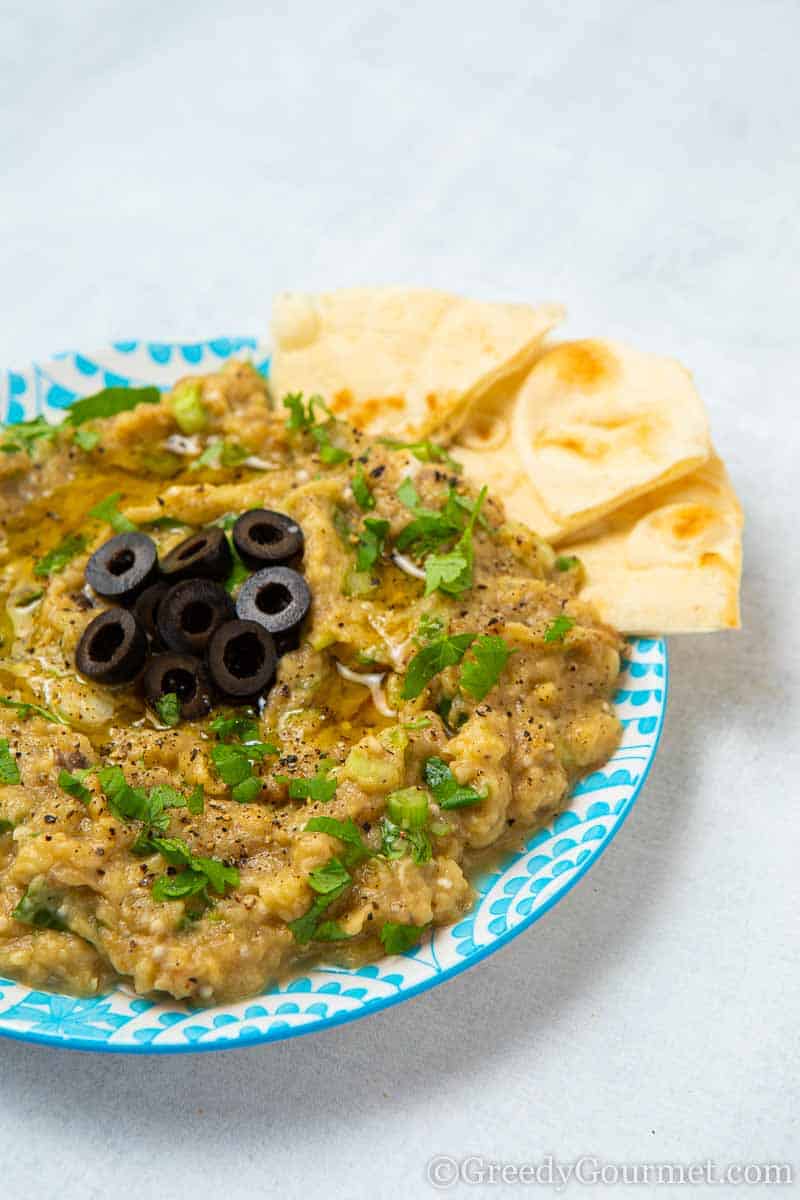Now you can make your very our authentic Greek tzatziki sauce recipe at home. This refreshing sauce, made from creamy Greek yogurt and grated cucumber, is an essential condiment in Greek food and the Middle East. Check out more dip recipes for more inspiration!

What is Tzatziki?
Tzatziki is a traditional Greek sauce featuring a mix of strained yogurt, grated cucumber, and fresh garlic, enhanced with fresh herbs like fresh dill and mint. This creamy cucumber yogurt sauce not only adds a refreshing taste to dishes but is also incredibly versatile, making it a popular dip for pita chips or a tasty topping for gyros and Greek salads.
The secret to achieving that authentic tzatziki texture is using whole milk yogurt, ideally full-fat plain Greek yogurt, to bring richness and depth to the flavors. Fat free yogurt will make it watery.

This refreshing sauce has become a beloved condiment in Mediterranean cuisine, making it a staple in many Greek restaurants.
How to Make Tzatziki Sauce

Making tzatziki sauce is easy, with just a few steps and simple ingredients.

- Start by grating the cucumber with the holes on a box grater, then place it in a fine mesh strainer or wrap in cheesecloth to remove as much liquid as possible.

- In a large mixing bowl, combine plain Greek yogurt, minced garlic, fresh lemon juice, a drizzle of extra virgin olive oil, and chopped fresh dill or fresh mint. For those who enjoy a richer texture, you can also add a touch of sour cream.

Allowing the sauce to chill in the refrigerator for an hour helps the flavors meld, creating a deeper, richer taste. Try this easy tzatziki sauce recipe at home, and you’ll find it rivals any restaurant’s version!
What to Eat with Tzatziki Sauce
This creamy tzatziki sauce pairs beautifully with a variety of dishes, offering a refreshing, creamy addition to any meal. Here’s how to enjoy this versatile sauce:
Would you like to save this?

- Serve tzatziki with warm pita bread for a classic Greek experience. The creamy dip complements the soft, fluffy texture of pita, making it a perfect appetizer or snack.
- Use tzatziki as a cooling dip for grilled meats like chicken beyti, lamb tikka or lamb shish kebabs. The tangy sauce adds a refreshing balance to the smoky flavors of the meat, making each bite extra flavorful.
- Drizzle tzatziki over fresh salads for a creamy, tangy twist. It works especially well with Mediterranean salads, adding richness without overpowering the natural flavors of fresh vegetables.
- Add a dollop of tzatziki alongside roasted veggies like carrots, bell peppers, or zucchini. The creamy sauce complements the caramelized flavors, making a simple vegetable dish more exciting.

- Dip a variety of fresh vegetables like cucumbers, carrots, and bell peppers into tzatziki for a healthy, satisfying snack. The sauce’s refreshing taste pairs wonderfully with the crisp crunch of fresh veggies.
- Add a spoonful of tzatziki on top of scrambled eggs for an unexpected but delicious twist. The tanginess of the yogurt sauce enhances the eggs' richness, making for a unique breakfast experience.
- Spread tzatziki on crackers for an easy, savory snack. This pairing is perfect for a quick bite or to serve as an appetizer, adding a Mediterranean flair to your usual cracker toppings.
- Pair tzatziki with grilled veggies for a cool, creamy contrast to the charred, earthy flavors of dishes like grilled zucchini, peppers, and eggplant.

How to Store Leftover Tzatziki Sauce
Storing leftovers is simple. Keep this dip in an airtight container in the refrigerator, which will stay fresh for up to 4 days.
If the squeezed cucumber releases excess water during storage, just stir it or strain it again if needed. This keeps your homemade tzatziki recipe creamy and ready to enjoy with grilled vegetables, pita, or as a sauce for various dishes.

FAQs
Do Greeks eat tzatziki by itself?
Yes, Greeks often enjoy creamy cucumber yogurt dip by itself, appreciating its fresh, tangy flavors.
What is the difference between Greek and Turkish tzatziki?
While Greek tzatziki is typically yogurt-based, Turkish variations may include more red wine vinegar and are often made with different herbs, creating a slightly different flavor profile.
What sauce is similar to tzatziki?
Raita is a similar sauce from Indian cuisine, focusing more on yogurt and herbs but usually less garlicky than tzatziki.
How to thicken this sauce?
To thicken the sauce, thoroughly strain the grated cucumber before mixing and opt for whole fat yogurt or full-fat Greek yogurt for a thicker, creamier consistency.
What are the ingredients in store-bought version?
Store-bought versions may contain preservatives and stabilizers, so making this recipe at home ensures the freshest ingredients and the best taste.
What’s the difference between tzatziki and tahini?
Tzatziki is a yogurt-based sauce with cucumber and garlic, whereas tahini is made from sesame seeds, giving it a nutty taste.
What’s the difference between raita and tzatziki?
Raita, commonly found in Indian cuisine, is less garlicky and often more yogurt-centric than tzatziki, focusing on cooling herbs and mild spices.
What is the most popular dip in Greece?
You guessed it — this sauce!

Do you love this recipe? Here are two other classic Greek dips you will enjoy: htipiti and melitzanosalata!
Print📖 Recipe

Tzatziki Recipe
- Total Time: 20 minutes
- Yield: 10 servings 1x
- Diet: Gluten Free
Description
Tzatziki is refreshing sauce, made from creamy Greek yogurt and grated cucumber, is an essential condiment in Greek food and the Middle East.
Ingredients
- ½ lb English cucumber, peeled and finely chopped
- 2 garlic cloves, finely minced
- 4 tbsp extra virgin olive oil
- 1 ½ oz fresh dill, finely chopped
- 2 lbs Greek yogurt
- kosher salt, to taste
- black pepper, to taste
Instructions
- Peel the cucumbers, then grate using a box grater.
- Place the grated cucumber in a sieve over a medium bowl, sprinkle generously with salt, and let it sit for 5 minutes to draw out the moisture.
- After 5 minutes, squeeze the cucumber to remove any excess water. Use paper towels if needed.
- In a food processor, blend the garlic and olive oil until you achieve a smooth paste.
- In a large bowl, combine the fresh cucumber, garlic paste, chopped dill, and Greek yogurt. Season with salt and pepper to taste.
- Mix everything thoroughly, using your hands if preferred, until all ingredients are well distributed.
- Transfer the dip to a serving bowl, drizzle a bit more olive oil on top, and enjoy!
Notes
You can use whole fat goat yogurt instead, if you prefer.
- Prep Time: 20 minutes
- Cook Time: 0 minutes
- Category: Starter
- Method: No Cook
- Cuisine: Greek
Nutrition
- Serving Size: A few dollops
- Calories: 151
- Sugar: 4 g
- Sodium: 41.2 mg
- Fat: 10.3 g
- Saturated Fat: 3 g
- Trans Fat: 0 g
- Carbohydrates: 7 g
- Fiber: 0.7 g
- Protein: 9.2 g
- Cholesterol: 11.8 mg









Marcel Lainglis
I remember having tzatziki in Greece, this one is right up there!
Renil M. George
Tzatziki is very tough but you were so detailed.
michelle
Thanks!
Jamie
There's no right and wrong way to make it...
Each person likes it differently and if you wanted to make real tzatziki traditional style than I would suggest getting 4-5 different recipes and work out what they do and don't have..
So I made this today at work..
All recipes I've come across have either got dill, mint and lemon juice and zest,
However I added about 1/2 to 1 tbs of honey to give a but of a sweet kick at the end ?
Turns out even better
Cassie
This would explain why I didn't get paste!
Nonna
Great as a starting point but Too much yoghurt surely!! Made this with 1/2 the yoghurt and shredded the cucumber instead of chopping it. Shredding gets out more water and makes the texture nicer. Added a squeeze of lemon juice and mint instead of dill. Yummy
Kevin
Regarding the dill vs. mint debate. Maybe it's simply a regional difference in Greece. Just a guess on my part.
Michelle
Hey, Al.
Indeed there is a roaring debate about dill vs mint. Ivy, who commented above, is a Greek, who lives in Greece. Meanwhile, Christos who featured in the photos is also a real Greek who lives in London and swears by dill.
I think at the end of the day, you can take your pick regarding which herb to use in your Tzatziki. After all, you're the one who has to eat it! 🙂
Michelle
Hey, Al.
Indeed there is a roaring debate about dill vs mint. Ivy, who commented above, is a Greek, who lives in Greece. Meanwhile, Christos who featured in the photos is also a real Greek who lives in London and swears by dill.
I think at the end of the day, you can take your pick regarding which herb to use in your Tzatziki. After all, you're the one who has to eat it! 🙂
Al
Great recipe! I'm confused however about the "any dip that contains sour cream or mint is not real Tzatziki". I've just looked at The Real Greek menu and it says:
TZATZIKI: Cool and tangy Greek yoghurt with cucumber, garlic, dill and fresh mint.
So I'm confused as to why, if this is not authentic, it is not as above? I'd love to know which is actually the right way and which isn't so I can ensure I'm making the most "authentic" Tzatziki at home. There seems to be a big debate on the Dill Vs. Mint subject. Maybe it's just personal preference and not every Greek makes it using just one of either?
Devin Columbus
What an awesome guide! You did an incredible job with the photos!
Jen
Delicious recipe! I only had one minor setback as a result of not reading closely enough. 20ml is 4 TEASPOONS. NOT 4 tablespoons...
Dimitris
I agree with your observations EXCEPT the dill. I never had tzatziki anywhere in Greece 40 years now, that uses mint. Dill may or may not be present but never had tzatziki with mint.
Dimitris
This is a true, authentic tzatziki, at last. The only thing missing, which is used in almost all homemade tzatziki I have tasted, is the vinegar - NEVER LEMON which is used in the US.
And I'm native Greek living in Greece.
Dimitris
This is a true, authentic tzatziki, at last. The only thing missing, which is used in almost all homemade tzatziki I have tasted, is the vinegar - NEVER LEMON which is used in the US.
And I'm native Greek living in Greece.
Ivy
Hi Michel, I saw your post on facebook and I was curious to see what this was all about. First of all love all your pictures. However, the tzatziki you describe above has nothing to do with real Greek tzatziki but rather an Americanized version:
I want to point what I disagree with the information given.
1. First of all we (Greeks) use a pestle and mortar to crush the garlic together with salt.
2. Greek cucumbers do not have seeds but I can understand that as it is probably addressed to people from all over the worls, so if there are seeds you should remove them. We don't chop cucumber but we grate it and then squeeze the water out of the cucumber.
3. We NEVER use dill in a tzatziki. Occasionally, mint is used.
4. We never use our hands to mix tzatziki.
5. Low fat Greek yoghurt with 2% fat makes excellent tzatziki.
Cheers,
Ivy
Rosa
Scrumptious! That is a sauce I very much love. Perfect with pita bread and souvlakis.
Cheers,
Rosa
Rosa
Scrumptious! That is a sauce I very much love. Perfect with pita bread and souvlakis.
Cheers,
Rosa